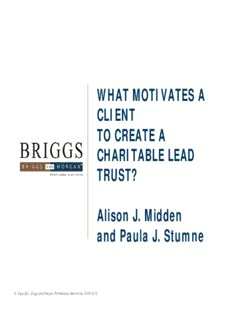
Alison J. Midden and Paula J. Stumne PDF
Preview Alison J. Midden and Paula J. Stumne
WHAT MOTIVATES A CLIENT TO CREATE A CHARITABLE LEAD TRUST? Alison J. Midden and Paula J. Stumne © Copyright, Briggs and Morgan, Professional Association, 2006-2012 Introduction • Charitable lead trusts (CLT) are becoming increasingly popular because the trust allows an individual to provide benefits to both charitable and noncharitable beneficiaries. 2 Introduction • CLTs can be created during lifetime (inter vivos) or at death in a will or trust (testamentary). 3 Introduction • In each year of the trust, the trustees will distribute an annuity or unitrust amount to charitable organizations either selected by the donor or by the trustees. • Upon termination of the trust, all of the property remaining in the trust will be distributed to the remainder beneficiaries, typically children. 4 Introduction • The initial term is known as the lead term. Thus, at the outset, the trust has two interests – a annuity or unitrust interest to a charity or charities, and an eventual remainder gift to individuals or a trust for individuals. The value of the individual’s remainder interest is reduced by the value of the charity’s lead interest. 5 Charitable Lead Annuity Trust (CLAT) • An irrevocable trust in which the trustee pays an annuity amount (the lead) to a charity or charities for a specified term. At the termination of that term, the trust property passes to individual (noncharitable) remainder beneficiaries, typically the donor’s children. 6 Charitable Lead Annuity Trust (CLAT) • Ex: A $1 million transfer to a 6% CLAT for 10 years would provide charity with an annual income stream of $60,000 per year for the 10-year term. 7 Charitable Lead Annuity Trust (CLAT) • Alternatively, the governing instrument of a CLAT may provide for an annuity amount that is initially stated as a fixed dollar or fixed percentage amount but increases during the annuity period, provided that the value of the annuity amount is ascertainable at the time the trust is funded. 8 Charitable Lead Trust Illustration CHARITABLE Transfers Children Remainder DONOR Assets to LEAD TRUST Trust (20 to 30 year term) Annuity Payments Charity Charity Benefits: • CLATs are generally created for a longer term (20-30 years) to “lock in” a low interest rate at inception. • CLATs work well in a low interest rate environment because if the trust’s investment performance exceeds the AFR rate, then the excess earnings and growth at the end of the term pass to the remainder beneficiaries tax free. The lower the AFR, the larger the potential gift to the family. Example: •Contribution of $1,000,000 to a CLAT that lasts for 15 years and pays 5% (or $50,000) annually to charity. With an AFR Rate of 2%, and assuming 7% growth of the assets, the result would be as follows: Charity receives $750,000 ($50,000 per year for 15 years). Remainder to family members (or a trust for their benefit) is $1,502,580. 9 Charitable Lead Unitrust (CLUT) • The required annual (or more frequent) payout to a charity or charities in a CLUT is based upon a fixed percentage of the trust value determined on the annual valuation date set forth in the trust document. Thus, the annual payout percentage remains constant but the required payout would change annually depending upon the value of the trust on the annual valuation date. 10
Description: